Found a total of 10000 related content

Why Can\'t Go Methods Defined on *T Be Used by T?
Article Introduction:Why Go Disallows Method Sets on *T to Be Used by TIn Go, methods defined on a value type T can be used by both T and *T, while methods defined on...
2024-10-31
comment 0
1005

Why Are Methods on `T` Not Usable by `*T` in Go?
Article Introduction:Why Go Discriminates Method Sets on T and *TIn Go, methods defined on a type T can be used by both T and T, while methods on T cannot be used by...
2024-10-31
comment 0
674

What are annotations and how do you create custom ones in Java?
Article Introduction:Custom annotations are defined by @interface and can contain elements with default values; 2. Use @Target to specify application targets such as methods or classes; 3. Use @Retention (RUNTIME) to make annotations read through reflection at runtime; 4. Get annotation information and process it through reflection at runtime; 5. Annotations can be used to simplify configuration and implement declarative programming, and are widely used in frameworks.
2025-08-06
comment 0
904

How to autoload classes in php
Article Introduction:Using Composer and PSR-4 is the recommended way to automatically load classes for PHP. The namespace and directory mapping is defined through composer.json, and the automatic loader is generated by running composerdump-autoload. The class file can be automatically loaded by introducing vendor/autoload.php into the entry file, without manual inclusion, improving code maintainability.
2025-08-24
comment 0
986

what are the different types of inner classes in java
Article Introduction:Java has four internal classes: member internal classes, static nested classes, local internal classes and anonymous internal classes. The member internal classes are non-static and need to be created through external class instances, which can access all members of the external class including private members; static nested classes are static and do not rely on external class instances, and can only access static members of the external class; local internal classes are defined in methods or code blocks, and can only access final or effectively final variables within the scope; anonymous internal classes have no name, and are used to temporarily implement interfaces or inheritance classes. They are often used for function interface implementation before event processing or functional programming. Since Java8, they are mostly replaced by lambda expressions; which internal class is chosen depends on whether they need to access external instances and scope scope
2025-08-24
comment 0
594
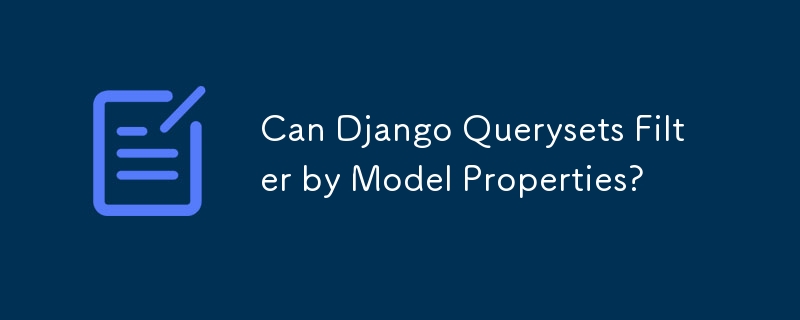
Can Django Querysets Filter by Model Properties?
Article Introduction:Filtering Django Querysets by Model Property: Understanding LimitationsWhile Django querysets offer extensive filtering capabilities, they cannot directly filter by model properties. Properties are custom attributes defined in model classes and calcu
2024-10-17
comment 0
648
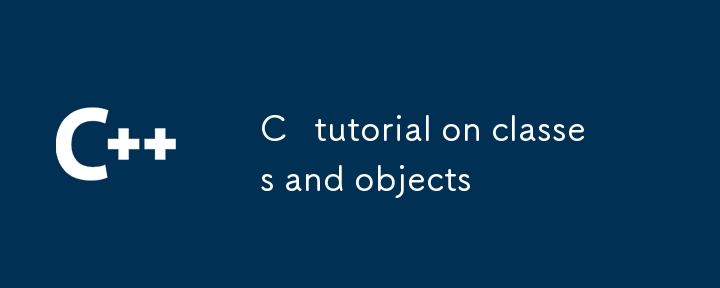
C tutorial on classes and objects
Article Introduction:In C, a class is a user-defined data type, a method to encapsulate and manipulate data, and an object is a specific instance of the class. 1. The class keyword is used to define the class, including member variables and member functions, and control visibility through access modifiers; 2. The object can be directly declared, defined or initialized by batches; 3. The constructor is used to initialize the object, without a return type, and can be overloaded; 4. Encapsulate the data protected through private, provide public method access and add verification logic. Mastering classes and objects is the basis for understanding OOP characteristics such as inheritance and polymorphism.
2025-06-30
comment 0
612

Abstract Classes in C
Article Introduction:Abstract classes are classes that cannot create objects and are used as base classes for other classes. It contains at least one pure virtual function, such as classShape{virtualvoiddraw()=0;}; in C. 1. Create abstract classes and define pure virtual functions; 2. Derivate classes and implement these functions; 3. Use base class pointers or references to derived class objects. For example, polymorphism is achieved by calling draw() by Shape*shape=newCircle();. Abstract classes are often used in framework design, graphics library, game development and database driver interfaces to ensure that subclasses implement functions consistently and improve code maintainability.
2025-07-23
comment 0
704
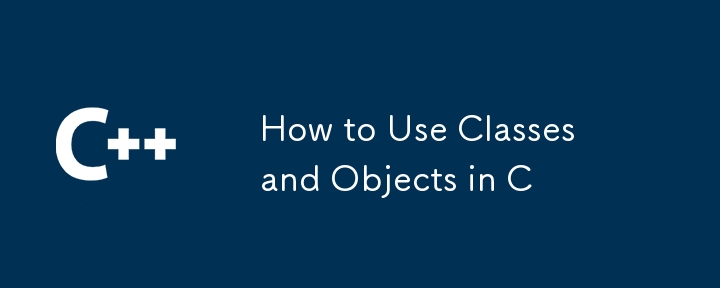
How to Use Classes and Objects in C
Article Introduction:The core of using classes and objects in C is to understand the basic concepts of classes as templates and objects as instances, and to master the encapsulation, construction and destruction mechanisms. 1. Classes are defined using class or struct. The default access rights are different. Member variables and functions can be set to private and public respectively. 2. Objects can be created through the stack or heap. Objects on the heap need to be manually released to avoid memory leaks. 3. Constructors are used to initialize objects, and destructors are used to clean up resources; 4. Complex relationships can be built between classes through combinations, making the program more flexible and easy to maintain. By mastering these key points, you can write object-oriented code with clear structure and clear logic.
2025-07-15
comment 0
244

Understanding Python Class and Object Concepts
Article Introduction:Classes and objects are the core of Python object-oriented programming. Classes are templates that describe objects with the same properties and behaviors. Objects are concrete instances of classes. 1. The class is defined using the class keyword, and uses the big camel nomenclature to initialize attributes through the init method; 2. The object is created through the class, and the attributes and calls methods can be accessed. Self represents the object itself and must be the first parameter of the method; 3. The attributes are used to store data, and the method is used to perform operations. It is recommended to unify the attributes in init; 4. The class variables belong to the class itself and are shared by all instances, while each instance variable is owned independently; 5. The mutable objects such as lists should not be directly set in the class by default, otherwise they will be shared by all instances, and should be initialized in init to avoid
2025-07-09
comment 0
809
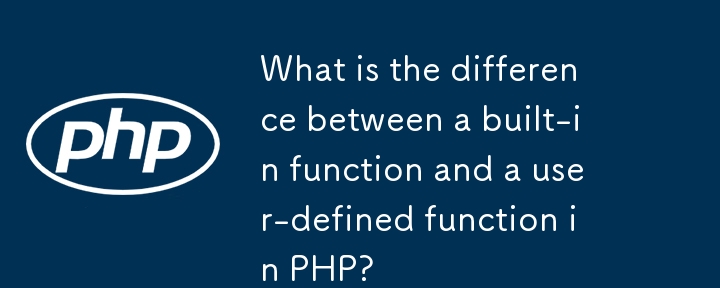
What is the difference between a built-in function and a user-defined function in PHP?
Article Introduction:Built-in functions in PHP are predefined functions that are available by default, while user-defined functions are created by developers themselves. Built-in functions such as strlen() and array_push() do not need to be defined, and are provided by the PHP core for common tasks. User-defined functions are created using function keywords, such as functiongreet(), for custom logic or code organization. There are differences in availability, naming, performance, portability and customization between the two. Built-in functions are faster and more stable, while user-defined functions are more flexible. Using built-in functions can improve efficiency, and using user-defined functions can enhance code modularity and reusability.
2025-07-21
comment 0
807

JavaScript and PHP Libraries Used by WordPress
Article Introduction:WordPress deeply relies on third-party JavaScript and PHP libraries, among which jQuery is the most widely used JavaScript library, and the PHP library is mainly composed of a single class file. Other JavaScript libraries used include jQuery Masonry, jQuery Hotkeys, jQuery Suggest, jQuery Form, jQuery Color, jQuery Migrate, jQuery Schedule, jQuery UI, Backbone, colorpicker, hoverIntent, S
2025-02-17
comment 0
882

Nested classes in python
Article Introduction:In Python, nested classes are used to improve structural clarity between logically closely related classes. For example, when nesting Engine classes in Car class, they can be defined through classCar:classEngine: and accessed through Car.Engine(). Its advantages include namespace management, readability improvement and auxiliary design patterns, but attention should be paid to avoid unrelated nesting, multi-layer nesting and over-encapsulation to avoid increasing maintenance difficulties.
2025-07-02
comment 0
535

What are the different list types in HTML
Article Introduction:HTML provides three main list types: 1. Ordered list () is used for items that are important in order, and the list items are defined by and labels, and are numbered by numbers by default; 2. Unordered list () is used for items that are independent of order, and are used and labels, and are usually displayed as dot symbols before the project; 3. Definition list () is used for terms and descriptions, including definition terms and definition descriptions, suitable for vocabulary or FAQ. The three lists can be nested with each other to build complex structures.
2025-08-06
comment 0
837


How to create and use a generic class in C#?
Article Introduction:Generic classes are used in C# to write flexible and type-safe code. 1. It allows not to specify specific types when defining a class, but pass them in when used, such as MyGenericClass; 2. Instance different types through MyGenericClass or MyGenericClass during use; 3. Restrict type characteristics through constraints (such as whereT:class,new()) to ensure security; 4. Commonly used in scenarios such as collection classes, tool classes, data access layer, etc. to improve reusability and uniformity; 5. Notes include: different generic instances are different types, not suitable for strong type association logic, support for multi-type parameters and generic methods that can be defined in non-generic classes.
2025-07-17
comment 0
371

What is a class in Python?
Article Introduction:Classes in Python are blueprints for creating objects, which contain properties and methods. 1. An attribute is a variable belonging to a class or its instance, used to store data; 2. A method is a function defined in a class, describing the operations that an object can perform. By calling the class to create an object, for example, my_dog=Dog("Buddy"), Python will automatically call the constructor __init__init__init object. Reasons for using classes include code reusability, encapsulation, abstraction, and effective modeling of real-world entities. Classes help keep the code clear and maintainable when building complex systems.
2025-07-09
comment 0
208
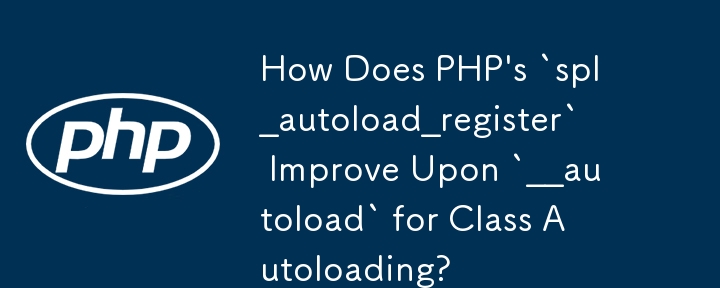

Python instance vs class variables
Article Introduction:Class variables are variables that are defined in a class but not in any method, belong to the class itself and are shared by all instances. ① Class variables are defined at the class level, and all instances share the same data by default; ② Modifying class variables requires the class name operation, otherwise an instance variable with the same name will be created without affecting other instances; ③ Instance variables are defined by self, and each object has an independent copy of the data, which is used to store object-specific status information.
2025-07-04
comment 0
913

What are anonymous classes in PHP and when might you use them?
Article Introduction:The main function of anonymous classes in PHP is to create one-time objects. 1. Anonymous classes allow classes without names to be directly defined in the code, which is suitable for temporary requirements. 2. They can inherit classes or implement interfaces to increase flexibility. 3. Pay attention to performance and code readability when using it, and avoid repeatedly defining the same anonymous classes.
2025-04-04
comment 0
1178



















